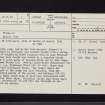Pricing Change
New pricing for orders of material from this site will come into place shortly. Charges for supply of digital images, digitisation on demand, prints and licensing will be altered.
Roslin
Battle Site (14th Century)
Site Name Roslin
Classification Battle Site (14th Century)
Alternative Name(s) Battle Of Roslin; Shin Banes Field; The Hewan; Killburne
Canmore ID 51798
Site Number NT26SE 1
NGR NT 2750 6411
Datum OSGB36 - NGR
Permalink http://canmore.org.uk/site/51798
- Council Midlothian
- Parish Lasswade
- Former Region Lothian
- Former District Midlothian
- Former County Midlothian
NT26SE 1 2750 6411.
(Name: NT 2750 6411) Site of Battle of Roslin (NR) AD 1303
OS 6" map (1957)
An English army, led by Sir John Segrave, Edward I's lieutenant in Scotland, had reached Roslin with a strong force of knights in three brigades when on 24th February 1303 they were caught and routed by a surprise attack made by a large party of mounted Scots led by John Comyn and Simon Fraser. Several place-names commemorate the battle, e.g. Shinbanes Field (NT 270 641), where many bones were afterwards found, 'The Hewan' where the onslaught of the enemy was most dreadful, from the precipitous nature of the ground, and Killburne (NT 273 640), a small brook said to have been discoloured with blood for three days. Tradition states that Mound Marl, a farm (Mountmarle: NT 279 639) was included in the scene of the battle.
NSA 1845; G W S Barrow 1965.
Online Gallery (1306 - 1329)
The year 2014 sees the 700th anniversary of the Battle of Bannockburn, in which the army of Robert I of Scotland defeated that of Edward II of England. The battle marked a major turning point in the long, drawn-out struggle of the Wars of Independence.
The Wars have had a lasting influence upon all the nations of the United Kingdom and upon the national story. Each age has seen fit to commemorate the events in its own way: through the perpetuation of the genuine historical associations of buildings and places and also through the endowment of others with improbable or fanciful traditions. Where past generations allowed its historic buildings to decay and disappear, later generations began to value and actively preserve these for their associations. Where an event lacked a tangible reminder, as at Kinghorn where Alexander III was killed in a riding accident, a commemorative monument would be erected to act as a focus. The Wars of Independence predate the fashion for accurate portraiture: the weathered, generic military effigy of Sir James Douglas is one of the few to survive in Scotland. Later centuries saw a need and supplied it by a crowd of images of its historic heroes, William Wallace and Robert the Bruce, each depicted according to contemporary taste and imagination. The opening of the new heritage centre at Bannockburn takes this into a new dimension, through the use of three-dimensional, digital technology.
RCAHMS Collections hold many images of these buildings and locations from battlefields, castles and churches, to the many commemorative monuments erected in later years. This gallery highlights a selection of these, including antiquarian sketches, photographic and drawn surveys, and architectural designs.
Excavation (24 November 2015 - 27 November 2015)
NT 27290 63712 (NT26SE 1) An evaluation, metal detector survey and small excavation were undertaken, 24–27 November 2015, on the site of the former Roslin Institute in advance of redevelopment of the site for housing. The evaluation covered 5% of the 2.5ha site and 23 trenches were
excavated within the accessible area. A total of 27 sherds of medieval pottery were recovered from a small feature in Trench 9 which was then extended. The subsequent excavation uncovered an extensive linear feature which split to form two termini at the northern extent along with three small pits and modern field drains. The linear feature may
represent the truncated base of a ditch.
Archive: NRHE (intended)
Funder: Ironside Farrar
Alan Hunter Blair – GUARD Archaeology Ltd
(Source: DES, Volume 17)
Information from GUARD Archaeology Ltd report (A H Blair) 2015
OASIS ID: guardarc1-232237








